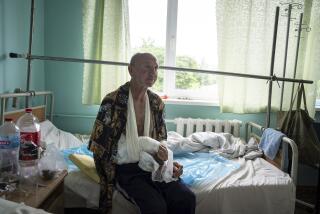Macedonian Official Vows to Restore Order to Villages
- Share via
SKOPJE, Macedonia — Interior Minister Ljube Boskovski triumphantly toured a virtually deserted and heavily damaged northern Macedonian village Saturday after government forces drove out ethnic Albanian rebels who had held it for three weeks, but fierce fighting erupted just a few miles away.
The capture of Vaksince is the most visible success by government forces since renewed fighting broke out early this month amid what the guerrillas say is a struggle for equal rights in Macedonia--and what the government charges is a separatist attempt to split off ethnic Albanian parts of the country. The fighting started in February.
“We will advance step by step until we restore order to these villages,” Boskovski told reporters accompanying him to Vaksince, a scene of bullet-pocked houses pierced by artillery shells. “The terrorists will be expelled from our Macedonian land until the last one is gone. There is no question about it.”
But police in the nearby village of Matejce reported coming under heavy mortar and sniper fire Saturday. The army later used helicopter gunships, artillery and tanks to target suspected guerrilla positions in Matejce and Slupcane, army spokesman Col. Blagoja Markovski said.
Macedonian television networks reported that fighting also raged Saturday in two other villages. By early evening, three police officers, three soldiers and one civilian had been injured on the government side, authorities said.
Ali Ahmeti, the guerrillas’ political leader, said in a telephone interview with the private A1 Macedonian television station that the rebels will not quit until they are recognized as negotiating partners in peace talks.
“We will stop the war at that moment when we get a guarantee that our demands for complete equality . . . are achieved,” Ahmeti said.
The area of fighting is near Macedonia’s border with the Yugoslav republic of Serbia and its province of Kosovo, and about 15 miles northeast of Skopje, the capital. Several contested villages are only about three miles west of the main road linking Skopje with Belgrade, the capital of Yugoslavia and Serbia. Those villages lie at the foot of the rugged Skopska Crna Gora mountain, which extends into Kosovo.
Peacekeepers in Kosovo led by the North Atlantic Treaty Organization have been trying with only limited success to cut off the guerrillas’ use of the province as a haven and a source of supplies.
Nearly 3,000 refugees have left the border area and crossed into southern Serbia, Macedonian officials say. The International Committee of the Red Cross reports that nearly 5,000 more civilians displaced by the fighting have sought refuge in the nearby town of Kumanovo. Thousands more remain in the areas of the clashes.
Boskovski predicted that “constitutional legal order” will be restored in the area and promised that the government “will make every effort to facilitate the return of citizens to their homes this summer so they can resume a normal life.”
Reporters with Boskovski saw no civilians in Vaksince but did view a sandbagged semi-basement in a half-constructed building that the guerrillas had used. Spent shells littered the streets.
The Organization for Security and Cooperation in Europe urged government forces Saturday to show restraint. Macedonia should use “only that force which is necessary and proportionate to respond to armed extremists,” said OSCE Chairman Mircea Dan Geoana, the Romanian foreign minister. “Political dialogue is the only feasible solution to the Macedonian situation.”
Meanwhile, a key leader of a different ethnic Albanian guerrilla force in southern Serbia’s Presevo Valley turned himself in to the KFOR peacekeeping force in Kosovo.
Shefket Musliu, commander of the Presevo, Medvedja and Bujanovac Liberation Army, the group’s political officer and two other guerrillas came to the boundary between Serbia proper and Kosovo early Saturday morning, KFOR said.
They crossed the border after attending the funeral of another guerrilla leader, Ridvan Cazimi, also known as Commander Lleshi, who was killed by a Serbian sniper Thursday. The slaying took place during NATO-approved deployment of Yugoslav forces into a buffer zone along the border between Kosovo and the rest of Serbia.
Musliu and the other three men were released after pledging that they would no longer fight in the Presevo Valley area, KFOR reported.
More to Read
Sign up for Essential California
The most important California stories and recommendations in your inbox every morning.
You may occasionally receive promotional content from the Los Angeles Times.













